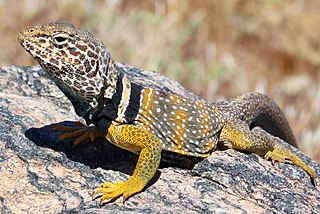
Gambelia is a genus of lizards, commonly known as leopard lizards, within the family Crotaphytidae. Leopard lizards are indigenous to arid environments of southwestern North America.

Crotaphytus is a genus of lizards, commonly known as collared lizards, in the family Crotaphytidae. Member species are small to medium-sized predators indigenous to the American southwest, Baja peninsula, and Mexico. Including the tail, they can be as small as 7 in (18 cm) or as long as 14 in (36 cm), and are characterized by distinct bands of black or brown around the neck, to which their common names refer.

Barkudia insularis, commonly known as the Madras spotted skink, is a critically endangered limbless skink which was described in 1917 by Nelson Annandale and rediscovered in the wild in 2003. Little is known about the species but it was previously believed to be found only in the mangrove habitats near Barkuda Island in Chilka Lake, Odisha, India. Later observations in adjoining parts of Odisha indicate a larger range within the state. The lizard looks like a large earthworm and lives in the subsoil and probably feeds on small arthropods.

The common collared lizard, also commonly called eastern collared lizard, Oklahoma collared lizard, yellow-headed collared lizard, and collared lizard, is a North American species of lizard in the family Crotaphytidae. The common name "collared lizard" comes from the lizard's distinct coloration, which includes bands of black around the neck and shoulders that look like a collar. Males can be very colorful, with blue green bodies, yellow stripes on the tail and back, and yellow orange throats. There are five recognized subspecies.

Gambelia sila, commonly known as the blunt-nosed leopard lizard, is a species of lizard in the family Crotaphytidae. The species is endemic to southern California.

The Great Basin collared lizard, also known commonly as the desert collared lizard or the Mojave black-collared lizard, is a species of lizard in the family Crotaphytidae. The species is endemic to the Western United States.

The Baja California leopard lizard, also known commonly as Cope's leopard lizard, is a species of lizard in the family Crotaphytidae. The species is endemic to Baja California and adjacent southern California.

The Baja California collared lizard or Baja black-collared lizard is a species of lizard in the family Crotaphytidae. The species is endemic to southern California and Baja California (Mexico).

Crotaphytus reticulatus, commonly called the reticulate collared lizard, is a species of moderately sized lizard in the family Crotaphytidae. The species is native to semiarid, rocky regions of the Tamaulipan mezquital. Its range includes the US state of Texas and the Mexican states of Coahuila, Nuevo León, and Tamaulipas. Of all the species in the family Crotaphytidae, C. reticulatus is the only species which is not restricted to rocky habitats.

Bothrops insularis, commonly known as the golden lancehead, is a highly venomous pit viper species found exclusively on the Ilha da Queimada Grande, off the coast of São Paulo state, in Brazil. The species is named for the light yellowish-brown color of its underside and for its head shape that is characteristic of the genus Bothrops. No subspecies of Bothrops insularis are currently recognized. It is one of the most venomous snakes in Latin America.

The black jackrabbit is a species of mammal in the family Leporidae. Endemic to Mexico, its only known location is Espiritu Santo Island in the Gulf of California. The IUCN has listed this species as a "vulnerable species" because of its restricted range. This taxon is regarded by some authorities as being a subspecies of the black-tailed jackrabbit, found on the mainland of Mexico.

The long-nosed leopard lizard is a species of relatively large North American lizard in the family Crotaphytidae. Gambelia wislizenii ranges in snout-to-vent length (SVL) from 8.3 to 14.6 cm. It has a large head, a long nose, and a long round tail that can be longer than its body. It is closely related to the blunt-nosed leopard lizard, which closely resembles the long-nosed leopard lizard in body proportions, but has a conspicuously blunt snout. The species G. wislizenii, once considered part of the genus Crotaphytus, is under moderate pressure because of habitat destruction but is categorized as "least concern".

The venerable collared lizard is a species of lizard in the family Crotaphytidae. The species is native to northern Mexico.
Grimser's collared lizard, also known commonly as the Sierra los Cucapas collared lizard and el cachorón de Sierra de los Cucapas in Mexican Spanish, is a species of lizard in the family Iguanidae. The species is endemic to Baja California, Mexico.
There are two species of lizard named eastern collared lizard:
Scelotes insularis is a species of lizard which is endemic to Mozambique.
Agama insularis, the insular agama, is a species of lizard in the family Agamidae. It is a small lizard found on Rooma Island in Guinea.
Crotaphytus dickersonae, also known commonly as Dickerson's collared lizard, the Mexican collared lizard, the Sonoran collared lizard, and el cachurón de azul de collar in Spanish, is a species of lizard in the family Crotaphytidae. The species is endemic to Mexico.













